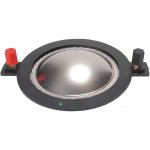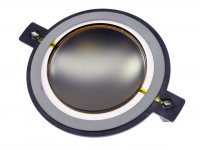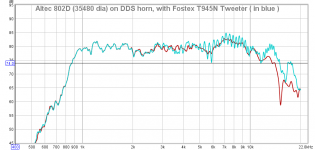Legend has it, one of JBL's former engineering masters, Greg Timbers as I recall, left the supertweeter in his Synthesis loudspeakers disconnected, because he preferred the (improved) coherence without it.
Last edited:
It's still not quite clear to me whether the D2 should mechanically and/or (just) electrically be considered a single driver or a coaxial, similar to the BMS drivers.
The voice coils are connected in series and there's a jumper that goes from front negative to rear positive. The diaphragms are separated, but work in tandem.
JBL says it's "crossover free".
The voice coils are connected in series and there's a jumper that goes from front negative to rear positive. The diaphragms are separated, but work in tandem.
JBL says it's "crossover free".
It's a single driver. Just with half the excursion per spl than a single diaphragm driver. Like the BMS 4599.
Yes I get that, but it's not as "single" as, for example Celestion's Axi2050 AxiPeriodic Driver.
One solution, albeit a very expensive one, to overcome at least some of the issues involved with supertweeters is to replicate Living Voice.
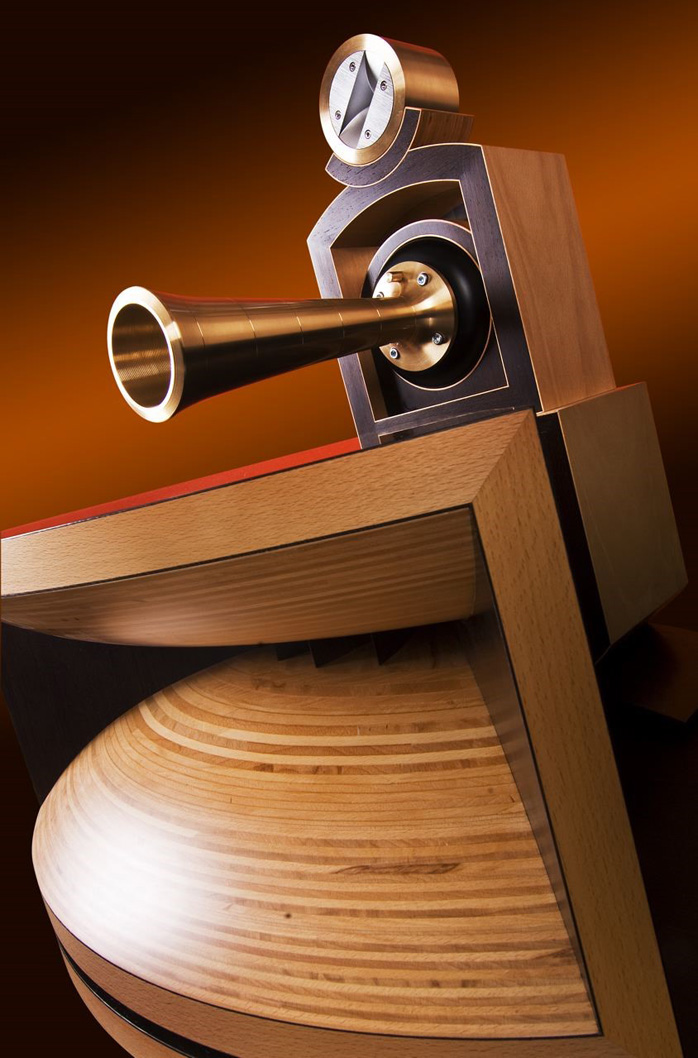
It's a little dated, but still an insightful comment from LV's Kevin Scott (6moons):
Continuing upwards on the driver array, the remaining two horn-loaded units are of Japanese providence, TAD to be precise. Their 1-inch throat model TAD2002 combines a Beryllium dome with an Alnico 3 motor. This driver has a useable bandwidth of 1kHz to 27kHz, an extraordinary specification. Living Voice however uses this unit only for HF duties by loading it with a modified exponential horn fabricated from seven pieces of cast LG2 bronze. The final unit at the top is a modified TAD Exclusive ET703, a slot dispersive compression driver again with a Beryllium diaphragm. This unit has a useable frequency range of 5kHz to 45kHz but Living Voice only runs it above 15kHz as a super HF driver.
The presence of this twin tweeter arrangement is perhaps the most surprising element of the Vox Olympian's profile. Anticipating confusion and armchair criticism from the peanut galleries, Kevin smirked. "All I was interested in was achieving the best possible result in musical terms. I am interested in music and in particular capturing human expression in musical performances. All design decisions were subject to this principal consideration. For example, we know that a drive unit’s behavior in its stop band (where it is progressively rolling off) is just as important as its behavior in its pass band. It is therefore preferable to operate the drive units comfortably within the most linear part of their bandwidth.
"I experimented with a lot of HF drivers and found that those which worked to my liking at 5kHz were attenuated or untidy by 20kHz. On the other hand the HF drivers that I was happy with at 20 or 30kHz sounded weak and fragile at frequencies below 10kHz even with third order filters. A two drive-unit HF solution was the best way to resolve this problem and achieve the results I found musically satisfying. We therefore operate the very high frequency unit or super tweeter only in its uppermost bandwidth, thus allowing it to behave tidily below its pass band. Similarly the main HF unit is used well above its low-frequency limit. This driver is loaded with a long bronze horn which has two functions. On the one hand it provides a strong and assured coupling of the driver to the room, something I find musically important.
On the other hand it provides a low-pass acoustic filter which helps us achieve a seamless integration with the super tweeter above it. This is an elegant solution that I find musically insightful, persuasive and engaging. I've worked on this project for 6 years and tried a great many reasonable and unreasonable permutations and this HF arrangement was very much to my liking. In the empirical development process, you discover odd little things that have great significance, are impossible to quantify but need to be understood and replicated. Similarly things of great theoretical importance can be quite benign.
For example I did not find that time-aligning the bass and midrange drivers was musically that significant. What I did find critical however was the time alignment of the midrange, HF and super HF drivers. These drivers are adjustable for output level via attenuators on the back of the cabinet. This allows for adjustments to be made to the tonal balance to suit different room types and sizes as well as partnering electronics. The super HF unit and HF units are therefore independently mobile relative to the midrange to allow in-situ fine tuning of the phase alignment. The super tweeter is mounted on a mobile carriage with a calibrated helical worm drive. Similarly the HF driver and horn is also independently mobile against a calibrated inlaid bronze index.
Also of great significance was the choice of materials throughout. A prior bespoke project involved casting a loudspeaker carcass out of LG2 bronze. This material had some very helpful and unexpected characteristics that I came to greatly admire. We therefore decided to prototype the HF horn of the Olympian in LG2 bronze. Simply replacing our preferred and highly evolved cast aluminum geometry with cast LG2 bronze was a delight and wonderful improvement.
It revealed a lithe, supple and succulent quality to the tonality, a radiant and naturally heterogeneous quality that made the aluminum sound pale, pastel and dry in contrast. We finally built the Olympian's modified exponential HF horn geometry from seven threaded sections of LG2 bronze*. The sections screw together on fine threads and are separated by a combination of paper and Sylomer** gaskets, which damp resonances in the bronze.
The inside of the horn has a rippled convoluted surface relief machined into it. The amplitude of these convolutions decreases towards the throat where the profile is completely smooth. This surface treatment has a surprisingly beneficial influence. The biggest hurdle is finding the time and money to support these endless prototyping explorations."
_____________________
* LG2 is an alloy of 85% copper, 5% zinc, 5% lead and 5% tin
** Sylomer in the particular form used is the standard in hi-tech vibration isolation of passenger cabins in pleasure cruise ships from the hull and engine compartments.

It's a little dated, but still an insightful comment from LV's Kevin Scott (6moons):
Continuing upwards on the driver array, the remaining two horn-loaded units are of Japanese providence, TAD to be precise. Their 1-inch throat model TAD2002 combines a Beryllium dome with an Alnico 3 motor. This driver has a useable bandwidth of 1kHz to 27kHz, an extraordinary specification. Living Voice however uses this unit only for HF duties by loading it with a modified exponential horn fabricated from seven pieces of cast LG2 bronze. The final unit at the top is a modified TAD Exclusive ET703, a slot dispersive compression driver again with a Beryllium diaphragm. This unit has a useable frequency range of 5kHz to 45kHz but Living Voice only runs it above 15kHz as a super HF driver.
The presence of this twin tweeter arrangement is perhaps the most surprising element of the Vox Olympian's profile. Anticipating confusion and armchair criticism from the peanut galleries, Kevin smirked. "All I was interested in was achieving the best possible result in musical terms. I am interested in music and in particular capturing human expression in musical performances. All design decisions were subject to this principal consideration. For example, we know that a drive unit’s behavior in its stop band (where it is progressively rolling off) is just as important as its behavior in its pass band. It is therefore preferable to operate the drive units comfortably within the most linear part of their bandwidth.
"I experimented with a lot of HF drivers and found that those which worked to my liking at 5kHz were attenuated or untidy by 20kHz. On the other hand the HF drivers that I was happy with at 20 or 30kHz sounded weak and fragile at frequencies below 10kHz even with third order filters. A two drive-unit HF solution was the best way to resolve this problem and achieve the results I found musically satisfying. We therefore operate the very high frequency unit or super tweeter only in its uppermost bandwidth, thus allowing it to behave tidily below its pass band. Similarly the main HF unit is used well above its low-frequency limit. This driver is loaded with a long bronze horn which has two functions. On the one hand it provides a strong and assured coupling of the driver to the room, something I find musically important.
On the other hand it provides a low-pass acoustic filter which helps us achieve a seamless integration with the super tweeter above it. This is an elegant solution that I find musically insightful, persuasive and engaging. I've worked on this project for 6 years and tried a great many reasonable and unreasonable permutations and this HF arrangement was very much to my liking. In the empirical development process, you discover odd little things that have great significance, are impossible to quantify but need to be understood and replicated. Similarly things of great theoretical importance can be quite benign.
For example I did not find that time-aligning the bass and midrange drivers was musically that significant. What I did find critical however was the time alignment of the midrange, HF and super HF drivers. These drivers are adjustable for output level via attenuators on the back of the cabinet. This allows for adjustments to be made to the tonal balance to suit different room types and sizes as well as partnering electronics. The super HF unit and HF units are therefore independently mobile relative to the midrange to allow in-situ fine tuning of the phase alignment. The super tweeter is mounted on a mobile carriage with a calibrated helical worm drive. Similarly the HF driver and horn is also independently mobile against a calibrated inlaid bronze index.
Also of great significance was the choice of materials throughout. A prior bespoke project involved casting a loudspeaker carcass out of LG2 bronze. This material had some very helpful and unexpected characteristics that I came to greatly admire. We therefore decided to prototype the HF horn of the Olympian in LG2 bronze. Simply replacing our preferred and highly evolved cast aluminum geometry with cast LG2 bronze was a delight and wonderful improvement.
It revealed a lithe, supple and succulent quality to the tonality, a radiant and naturally heterogeneous quality that made the aluminum sound pale, pastel and dry in contrast. We finally built the Olympian's modified exponential HF horn geometry from seven threaded sections of LG2 bronze*. The sections screw together on fine threads and are separated by a combination of paper and Sylomer** gaskets, which damp resonances in the bronze.
The inside of the horn has a rippled convoluted surface relief machined into it. The amplitude of these convolutions decreases towards the throat where the profile is completely smooth. This surface treatment has a surprisingly beneficial influence. The biggest hurdle is finding the time and money to support these endless prototyping explorations."
_____________________
* LG2 is an alloy of 85% copper, 5% zinc, 5% lead and 5% tin
** Sylomer in the particular form used is the standard in hi-tech vibration isolation of passenger cabins in pleasure cruise ships from the hull and engine compartments.
Last edited:
Since then, the TAD ET703 has been replaced by a Vitavox supertweeter, specifically designed for Living Voice.
An externally hosted image should be here but it was not working when we last tested it.
Since then, the TAD ET703 has been replaced by a Vitavox supertweeter, specifically designed for Living Voice.
An externally hosted image should be here but it was not working when we last tested it.
Only in the Palladian, which is the "cheaper" version.
They still use the TAD in the Olympian.
Between HF200, HF204 and HF206, what would you (who tested/listened) chose?
Intended for a K402 replica MEH horn, 30mp room. Using 12PE32 as mid-bass.
Thanks!
Intended for a K402 replica MEH horn, 30mp room. Using 12PE32 as mid-bass.
Thanks!
I'd recommend talking to Bob Crites on the Klipsch forum (@BEC) or at B&K Sound, who perhaps has heard a few of those drivers on a K-402.Between HF200, HF204 and HF206, what would you (who tested/listened) choose?
I've heard the HF20AT extensively (~days of listening time), which has a titanium dome diaphragm. This is a significant improvement over the Klipsch-supplied B&C (rebranded) driver. It is somewhat surprising to me how much difference there is between these two drivers in terms of 10-20 kHz listening performance. The impulse spectrograms between those two drivers (HF20AT and K-691) tells the story. First the K-691 (measured at room corner on top of a KPT-KHJ-LF horn-loaded bass bin):
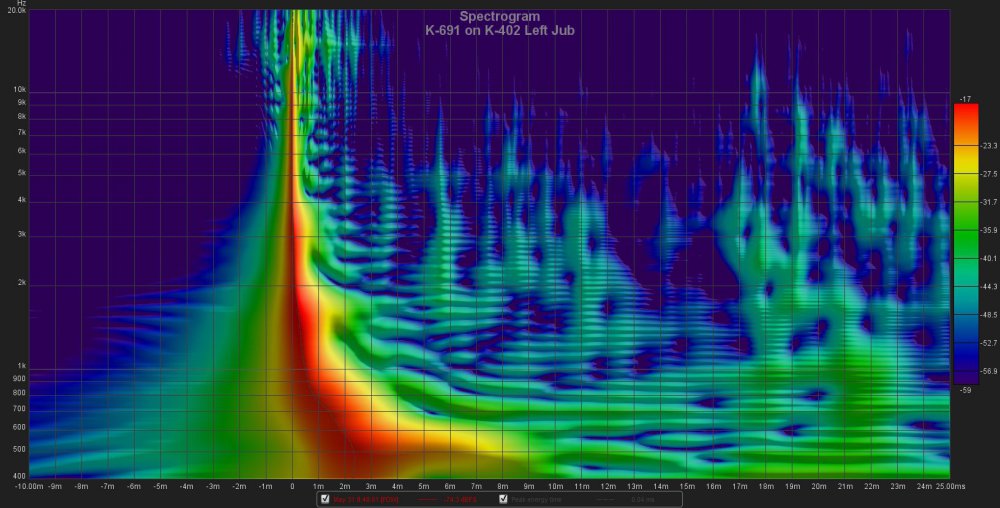
and the FaitalPRO HF20AT:

and, for reference, the TAD TD-4002:
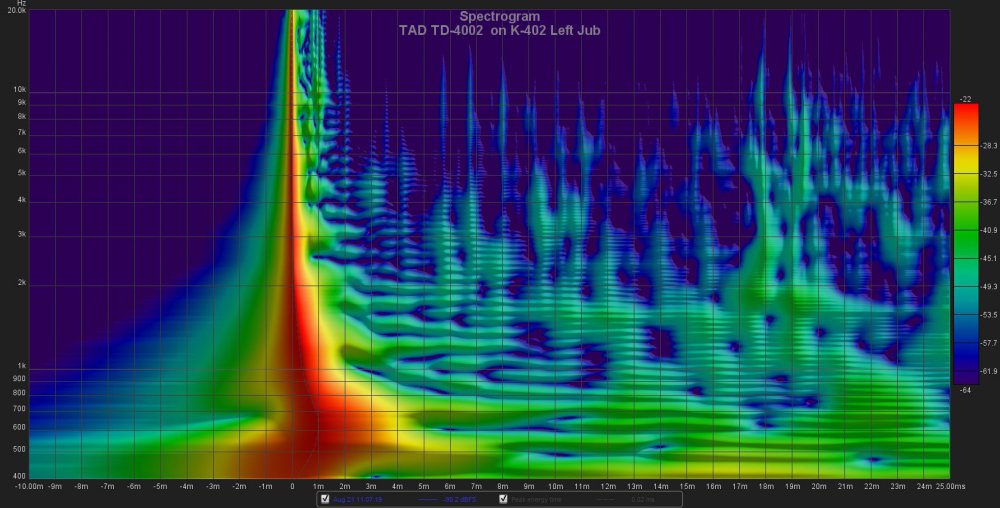
Chris
Which will measure and, more importantly, sound quite different from this:
Attachments
Last edited:
I dunno, I always used to object to a tweeter when Jean Hiraga added it to his Altec A5 system. Whenever I used them, I liked them better as a two way. Everyone else liked he tweeter, to me it sounded fake. Nice, but fake.
But years later when I built my own A5, I found that my 288 drivers just didn't have enough top end, or lat least not enough clean top end. Thus a pair of Fane bullet tweeters were added coming in at about 7200 Hz. They did help and I liked them. But try as I might with phase, delay, placement, etc - it didn't make any audible difference unless they were waaaay off.
But years later when I built my own A5, I found that my 288 drivers just didn't have enough top end, or lat least not enough clean top end. Thus a pair of Fane bullet tweeters were added coming in at about 7200 Hz. They did help and I liked them. But try as I might with phase, delay, placement, etc - it didn't make any audible difference unless they were waaaay off.
Only in the Palladian, which is the "cheaper" version.
They still use the TAD in the Olympian.
Yes, but the question is: "For how long?"
TAD ceased production of the ET-703 some time ago and it appears Cessaro secured a large part of the remaining stock:
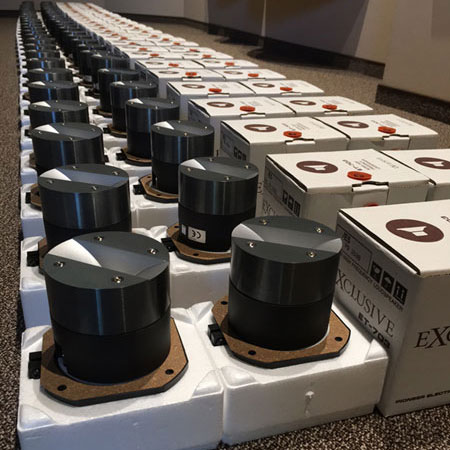
I dunno, I always used to object to a tweeter when Jean Hiraga added it to his Altec A5 system. Whenever I used them, I liked them better as a two way. Everyone else liked he tweeter, to me it sounded fake. Nice, but fake.
But years later when I built my own A5, I found that my 288 drivers just didn't have enough top end, or lat least not enough clean top end. Thus a pair of Fane bullet tweeters were added coming in at about 7200 Hz. They did help and I liked them. But try as I might with phase, delay, placement, etc - it didn't make any audible difference unless they were waaaay off.
This is a nice description. I guess some of us recognize your initial experience and agree with the second part, I do.
I guess it depends on the drivers and horns. Modern waveguide type of horns (shallow, high flare rate) are likely to sound better without a supertweeter.
Last edited:
How bad or good would be using phenolic CD 2" to reproce from 500Hz and cross with Ti CD 1" from 3000Hz or higher?
I dunno, I always used to object to a tweeter when Jean Hiraga added it to his Altec A5 system. Whenever I used them, I liked them better as a two way. Everyone else liked he tweeter, to me it sounded fake. Nice, but fake.
But years later when I built my own A5, I found that my 288 drivers just didn't have enough top end, or lat least not enough clean top end. Thus a pair of Fane bullet tweeters were added coming in at about 7200 Hz. They did help and I liked them. But try as I might with phase, delay, placement, etc - it didn't make any audible difference unless they were waaaay off.
As you might remember, I've gone without tweeters ( though I own many ) for at least 15 years ( while getting tweeterish sounds from my 288-8Ks ).
Sadly, for some time now I've been noticing that above @ 4K they just aren't as responsive as they once were.
- Naturally based on my 60+ age I was blaming my ears ( until I swapped in some Celestion CDX1-1745 drivers that restored that range in spades.
- The thing here is that the loss of response does not show-up in any response sweeps that I've made.
So I'm now faced with buying new diaphragms from GPA for my 288's ( not going to happen any time soon ) or finding a way of making do ( while restoring the lost responsiveness of that range ).
To that end I've just recently started using a Fostex T945N aimed at the wall behind the speakers ( it's an ongoing experiment, especially when paired up with other mid drivers ).
For instance; when paired up with my Altec 802D's ( which are about 4-6db less efficient than the Tweeters ) the tweeter splash is still very much present in the over all sonic presentation ( even though the tweeter faces rewards ).
See;
Even this single tweeter is quite noticeable due to the extra "air, haze or ambiance" ( pick a term ) that it adds.
- I'm sure that if I wire up two tweeters I'll be turning them down by a decent margin.
Aimed backwards, it has yet to spoil the superb imaging I'm able to enjoy ( though I can certainly hear it softening-up some of the usually razor sharp transients that do help with imaging ).
🙂
Attachments
How bad or good would be using phenolic CD 2" to reproce from 500Hz and cross with Ti CD 1" from 3000Hz or higher?
It depends on the horn and the Phenolic driver, is this a Selenium or old JBL?
@EarlK, which DDS horn is in front of the 802D?
My experience with oldskool drivers is limited, but experiments by other diy-ers have shown these often don't go well with waveguides.
For this reason it's quite surprising the Faital Pro's appear to be an exception, as they have a conical adaptation horn. I suspect the phase-plug design is a key factor here.
My experience with oldskool drivers is limited, but experiments by other diy-ers have shown these often don't go well with waveguides.
For this reason it's quite surprising the Faital Pro's appear to be an exception, as they have a conical adaptation horn. I suspect the phase-plug design is a key factor here.
Last edited:
Thanks for that Earl. I also tried the splash tweeters and found them to be OK. I usually ended up playing them straight ahead, tho, out of guilt or embarrassment something. 
I suspect that different people hear things differently. I don't get much, if any, spacial benefit from tweeters, more of a tonality benefit. Like warmth on strings.

I suspect that different people hear things differently. I don't get much, if any, spacial benefit from tweeters, more of a tonality benefit. Like warmth on strings.
- Home
- Loudspeakers
- Multi-Way
- Smallest Footprint Horn and Driver that can reach 500 Hz
